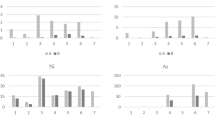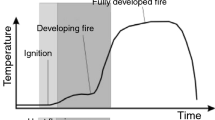Abstract
Granularity is one of the primary extrinsic factors that can influence the process of coal spontaneous combustion. Lignite was selected for studying the influence of granularity. A self-developed temperature-programmed oil bath experimental system was adopted to capture the changes in the spontaneous combustion characteristic parameters for different particle sizes. Moreover, the microcrystalline structure and functional group distribution of different granularities were obtained using an X-ray diffractometer and Fourier transform infrared spectrometer. The results show that the microcrystalline structure, the types of functional groups and the release order of gases of different granularities have equal influence during the process of coal spontaneous combustion. A smaller granularity has a lower aromatic group content and a higher content of high-activity hydroxyl groups, aliphatic hydrocarbons and oxygen-containing functional groups. Moreover, a smaller particle size results in a lower critical temperature. The distributions of coal granularity also affect the characteristic of coal spontaneous combustion. A wide particle size distribution produces a larger surface area for contact between coal and oxygen than a narrow distribution, which results in a coal with a stronger spontaneous combustion tendency.







Similar content being viewed by others
References
Qin Y, Wang L, Yang X, Wang C, Wang Y. Experimental study of different granularity on the gas absorption of coal. Procedia Eng. 2011;26:93–100.
Ren TX, Edwards JS, Clarke D. Adiabatic oxidation study on the propensity of pulverised coals to spontaneous combustion. Fuel. 1999;78:1611–20.
Chunmiao Y, Dezheng H. L Chang. Gang. Ignition behavior of magnesium powder layers on a plate heated at constant temperature. J Hazard Mater. 2013;246–247:283–90.
Abbas-Abadi MS, Haghighi MN, Yeganeh H, et al. The effect of melt flow index, melt flow rate, and particle size on the thermal degradation of commercial high density polyethylene powder. J Therm Anal Calorim. 2013;114:1333–9.
Jabłoński M. Influence of particle size distribution on thermokinetics of ilmenite with sulphuric acid reaction. J Therm Anal Calorim. 2009;96:971–7.
Ozbas KE. Effect of particle size on pyrolysis characteristics of Elbistan lignite. J Therm Anal Calorim. 2008;93:641–9.
Waheed QMK, Wu C, Williams PT. Pyrolysis-reforming of rice husks with a Ni-dolomite catalyst: Influence of process conditions on syngas and hydrogen yield. J Energy Inst. 2015;89:657–67.
Xiao Y, Li Q, Deng J, et al. Experimental study on the corresponding relationship between the index gases and critical temperature for coal spontaneous combustion. J Therm Anal Calorim. 2017;127:1009–17.
Deng J, Zhao J, Xiao Y, et al. Thermal analysis of the pyrolysis and oxidation behaviour of 1/3 coking coal. J Therm Anal Calorim. 2017;129:1–8.
Liu R, Zhao W, Zhang T, et al. Particle refinement and graphene doping effects on thermal properties of potassium picrate. J Therm Anal Calorim. 2014;118:561–9.
Xu X, Liu Y, Li Z, et al. Thermal study of boehmite nanofibers with controlled particle size. J Therm Anal Calorim. 2014;115:1111–7.
Lai W, Xue Y, et al. Effects of particle size on properties of chemical reaction thermodynamics of nanosystems. Acta Phys-chim Sin. 2007;23:508–12.
Azhagurajan A, Nagaraj P. An experimental analysis of coal aluminium mixture in coal fired furnace. J Therm Anal Calorim. 2009;98:253–9.
Sorescu M, Xu T. Particle size effects on the thermal behavior of hematite. J Therm Anal Calorim. 2012;107:463–9.
Burton A, Wu H. Influence of biomass particle size on bed agglomeration during biomass pyrolysis in fluidised bed. Proc Combust Inst. 2017;36:2199–205.
Nugroho YS, Mcintosh AC, Gibbs BM. Low-temperature oxidation of single and blended coals. Fuel. 2000;79:1951–61.
Coda B, Tognotti L. The prediction of char combustion kinetics at high temperature. Exp Therm Fluid Sci. 2000;21:79–86.
Duz M, Tonbul Y, Baysal A, et al. Pyrolysis kinetics and chemical composition of Hazro coal according to the particle size. J Therm Anal Calorim. 2005;81:395–8.
Yu D, Xu M, Sui J, et al. Effect of coal particle size on the proximate composition and combustion properties. Thermochim Acta. 2005;439:103–9.
Deng J, Xu JC. Experimental and numerical analysis on the shortest spontaneous combustion period of coal. J China Coal Soc. 1999;3:274–8.
Benedetto AD, Russo P, Amyotte P, et al. Modelling the effect of particle size on dust explosions. J Chem Eng Sci. 2010;65:772–9.
Liu R, An E, Wu K, et al. Numerical simulation of oxy-coal MILD combustion with high-velocity oxygen jets. J Energy Inst. 2017;90:30–43.
Zhou Y, Liu J, Liang D, et al. Effect of particle size and oxygen content on ignition and combustion of aluminum particles. Chin J Aeronaut. 2017;30:1835–43.
Liu W, Qin Y, Yang X, et al. Experimental study for impact of volatile matter on spontaneous combustion characteristics of coal. J China Coal Soc. 2014;39:891–6.
GB 474–2008. Standard of China–Method for preparation of coal sample. ISO 18283, 2006. Hard coal and coke–Manual sampling. P. R. China.
Zhang H, Pu W, et al. Influence of acid treatment on the properties of pulverized coals with low ash content. J Eng Therm. 2009;30:699–702.
Xu J. Determination theory of coal spontaneous combustion zone. Beijing (PR China): China Coal Industry Publishing House; 2001.
He X, Liu X. Baisheng Nie, Dazhao Song. FTIR and Raman spectroscopy characterization of functional groups in various rank coals. Fuel. 2017;206:555–63.
Ban Y, Tang Y, Wang J, et al. Effect of inorganic acid elution on microcrystalline structure and spontaneous combustion tendency of Shengli lignite. J Fuel Chem Technol. 2016;44:1059–65.
Qi X, Guo X, Xue L, et al. Effect of iron on Shenfu coal char structure and its influence on gasification reactivity. J Anal Appl Pyrolysis. 2014;110:401–7.
Lu L, Sahajwalla V, Harris D. Veena Sahajwalla A, David Harris. Characteristics of Chars Prepared from Various Pulverized Coals at Different Temperatures Using Drop-Tube Furnace. Energy Fuels. 2000;14:869–76.
Zhang Y, Deng J, Yang H, et al. Experimental study of the characteristic features of the microstructure of coal at different coal sorts. J Saf Environ. 2014;14:67–71.
Solomon PR, Carangelo RM. FTIR analysis of coal; aliphatic and aromatic hydrogen concentration. Fuel. 1988;67:949–59.
Xu T, Wang D, Xin H, et al. Experimental Study on the Temperature Rising Characteristic of Spontaneous Combustion of Coal. J Min Saf Eng. 2012;29:575–9.
Acknowledgements
This study is grateful to the National Natural Foundation Project (No. 51674191), the Natural Science Foundation of Shanxi Province (No. 2016JM5016) and the China Postdoctoral Science Foundation (No. 2016JM592902XB) for financial support.
Author information
Authors and Affiliations
Corresponding authors
Rights and permissions
About this article
Cite this article
Zhang, YN., Chen, L., Deng, J. et al. Influence of granularity on thermal behaviour in the process of lignite spontaneous combustion. J Therm Anal Calorim 135, 2247–2255 (2019). https://doi.org/10.1007/s10973-018-7440-3
Received:
Accepted:
Published:
Issue Date:
DOI: https://doi.org/10.1007/s10973-018-7440-3




